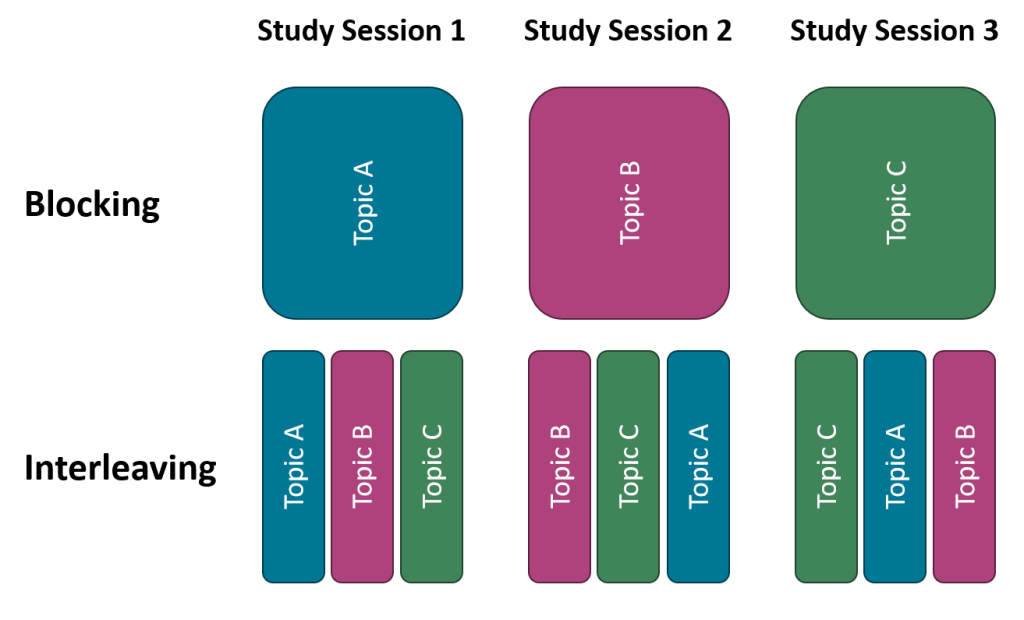Exploring Interleaving

Exploring Interleaving
Interleaving involves switching between topics during a study session. This helps students to see the connections between concepts and subjects, and supports students in identifying the correct strategy to solve a problem.
Learning Outcomes
After completing this module, you will be able to:
- Explain the principle of interleaving
- Describe how interleaving improves learning
- Indentify the barriers to using interleaving
- Demonstrate how to use interactive learning tools to support interleaving
Understanding Interleaving
The principle of interleaving is built around the idea that students learn content more thoroughly when they alternate between different topics or types of problems during a single study session. This differs from how most students structure their study sessions. Typically, students study in blocks, where they focus on a single topic area for an extended period of time. Students prefer blocking, because they tend to recall more information and answer more questions correctly during the study session; however, blocking tends to result in lower test scores than interleaving.
Interleaving benefits learning by helping students to differentiate between different types of problems, recognize correct strategies used to solve the different problems, and to build connections between related content. When different topics, problems, and questions are presented together, students can more easily identify differences between them. By working with multiple topics in a study session, in shorter chunks of time, students must retrieve information stored in their long-term memory which reinforces those connections and even creates new ones. Modelling interleaving in learning activities will familiarize students with the strategy, increasing their comfort and the likelihood of them trying it out on their own.

Interleaving – Video
The following three minute video is an introduction to interleaving. It explores what interleaving is and how it can support students in their learning. Feel free to include this short video into your own courses to guide students as they explore effective learning techniques. You can find this video at the following link: Tactic 2: Interleaving Video
The following are some interesting and creative ways to use this video:
- Present it in class during a description of practice or homework activities.
- Assign it for review and ask students to come up with their own interleaving schedule.
Interleaving – Infographic
You may want to share this infographic with your students to help them understand how they can use interleaving for learning:
Attribution- Creative Commons-NonCommercial-NoDerivs by The Learning Scientists
Barriers to Interleaving
Within this section we explore some roadblocks that can prevent students from engaging in this particularly learning technique. These can be used in a number of ways:
- establish a reflective checklist for students to assist them in assessing their previous habits and methods of studying
- support discussions about progress and next steps with students
- as a means of feedback to support students while they build their competency with learning
Resistance to Using Interleaving
- This type of studying may be unfamiliar to students, consequently resulting in them reverting to their normal study patterns. While some students have strong study strategies, many do not, but their own pattern is what is comfortable and familiar.
- Students must plan their studying and begin well in advance of their assessment. Many students leave studying to the last minute, believing that cramming the night, or hours before will yield better results because the information is fresh in their brain; however, this results in surface level memory, which does not allow for the development of durable learning that is required for critical thinking and problem solving.
- Interleaving is more time consuming than blocking so students may not get through as much material during a study session as they expect. Students are required to sort through different types of information and identify the correct problem-solving or response strategies when interleaving, resulting in longer times to answer questions.
Challenges Students May Face Using Interleaving
- Students may struggle with interleaving if they have not been provided with enough instruction or practice of individual skills. The learning benefits of interleaving are greatest when students have achieved some competence through blocked practice.
- Students may initially struggle to recall information, creating discomfort and the impression that interleaving is an ineffective study strategy and give up on it. When students are able to focus solely on one topic or type of question, that information remains in their working memory, enabling fast, reliable recall during and immediately following their study session. This may lead to the student feeling overconfident that they have learned the content and will remember it, but it is unlikely they know the material deeply for future recall.
- Interleaving may not be equally effective in all areas of learning. Learning that involves problem-solving (e.g. mathematics, medical diagnosis) is boosted with interleaving; learning that involves rote memorization (e.g. vocabulary) is not.
References
Photography on this page used with permission from the Durham College Online Photo Database.
Dunlosky, J. (2013). Strengthening the Student Toolbox: Study Strategies to Boost Learning. American Educator, 37(3), 12–21. https://files.eric.ed.gov/fulltext/EJ1021069.pdf
Dunlosky, J., Rawson, K.A., Marsh, E.J., Nathan, M.J., & Willingham, D.T. (2013). Improving students’ learning with effective learning techniques: Promising directions from cognitive and educational psychology. Psychological Science in the Public Interest, 14(1), 4-58. https://doi.org/10.1177/1529100612453266
Karpicke, J. D., & O’Day, G. M. (in press). Elements of effective learning. In M. J. Kahana & A. D. Wagner (Eds.), Oxford Handbook of Human Memory, Volume II: Applications. Oxford University Press. https://learninglab.psych.purdue.edu/downloads/inpress_Karpicke_ODay_Oxford_Handbook.pdf
Rohrer, D., & Pashler, H. (2007). Increasing retention without increasing study time. Current Directions in Psychological Science, 16(4), 183-186. https://doi.org/10.1111/j.1467-8721.2007.00500.x
The Learning Scientists. (n.d.). Interleaving. The Learning Scientists. https://www.learningscientists.org/interleaving
Weinstein, Y., Madan, C.R. & Sumeracki, M.A. (2018). Teaching the science of learning. Cognitive Research: Principles and Implications, 3(2). https://doi.org/10.1186/s41235-017-0087-y
Weinstein Y., & Smith, M. (2016, August 11). Learn to study using… interleaving. The Learning Scientists. https://www.learningscientists.org/blog/2016/8/11-1
© Durham College. All rights reserved.

